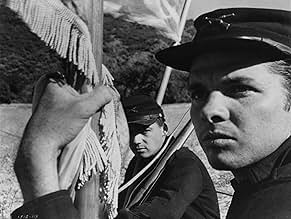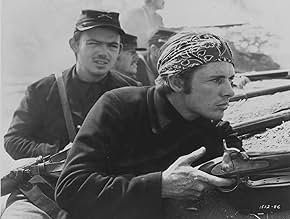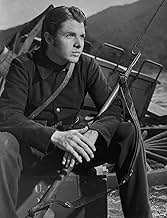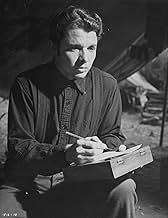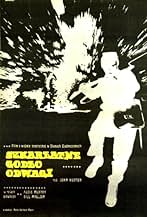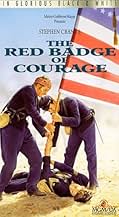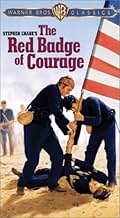NOTE IMDb
7,1/10
5,2 k
MA NOTE
Adaptation tronquée du roman de Stephen Crane sur un soldat de l'Union pendant la guerre de Sécession qui s'efforce de trouver le courage de se battre dans le feu de l'action.Adaptation tronquée du roman de Stephen Crane sur un soldat de l'Union pendant la guerre de Sécession qui s'efforce de trouver le courage de se battre dans le feu de l'action.Adaptation tronquée du roman de Stephen Crane sur un soldat de l'Union pendant la guerre de Sécession qui s'efforce de trouver le courage de se battre dans le feu de l'action.
- Réalisation
- Scénario
- Casting principal
- Nomination aux 1 BAFTA Award
- 2 victoires et 1 nomination au total
Robert Easton
- Thompson
- (as Robert Easton Burke)
Don Anderson
- Soldier
- (non crédité)
Smith Ballew
- Union Captain
- (non crédité)
Albert Band
- Union Soldier Fording River
- (non crédité)
Gregg Barton
- Soldier
- (non crédité)
Whit Bissell
- Wounded Officer
- (non crédité)
Robert Board
- Soldier
- (non crédité)
Chet Brandenburg
- Wounded Soldier
- (non crédité)
Edwin Breen
- Confederate Flag Bearer
- (non crédité)
Joe Brown Jr.
- Soldier
- (non crédité)
Avis à la une
Keep in mind that many people involved with this film were WW2 vets. That's important, as I think it made a HUGE difference in how the film came out. Audie Murphy was the most decorated American soldier of WW2. Bill Mauldin wasn't a line soldier, but he'd been in the infantry before the war. He knew what the daily life of a grunt was all about. And director John Huston had directed films in WW2, standing at the front lines in Italy to do so. They all knew what war should look like. Had these people not been involved, I think this movie wouldn't have rung true as it did then and does today. Sure, the weapons, most of the uniforms and equipment are horribly wrong (this was in the days when a "trapdoor" Springfield rifle and Indian War era equipment was just fine for a Civil War film), but this film must be viewed on it's acting and photography. They got it across what it was like to be SHOT at, and how it felt to be terrified in battle, better than any film since, "All Quiet of the Western Front." Yes, it's seriously abridged and condensed (quite a feat when you consider how short the book is), but it gets the spirit across just fine. It's not perfect by any measure, but you'll never be able to get such a group together to re-make this film and have ring as trued as this classic.
stephen crane's best work. audie murphy's best work. any serious student of the civil war will recognize this film as the best, most honest portrayal of civil war action. it captures the fear and dread of deadly combat like no other film on the american civil war. during bloody battles, if your side was not having a successful day, the usual way out was "skedaddling" or running like the wind. both sides did it. a great little film that all civil war students and scholars should own and view every so often.
Deserves more credit than it currently receives. The directing alone is awesome, with the number of unique and different shots that Huston came up with really takes this Pic away from the norm.
Some of the realism in the portrayals that would be lost on some American viewers include the scene where the General talks to the troops before the battle, asking them what they are going to eat for dinner. He goes from group to group asking the same questions - why? Remember (duh), no radios, no public address system. Commanders had to spread their message by repeating it over and over - inspiring a different group each time.
A very enjoyable 69 minutes. Sad that the studio had to meddle with the original cut (what else is new?).
F
Some of the realism in the portrayals that would be lost on some American viewers include the scene where the General talks to the troops before the battle, asking them what they are going to eat for dinner. He goes from group to group asking the same questions - why? Remember (duh), no radios, no public address system. Commanders had to spread their message by repeating it over and over - inspiring a different group each time.
A very enjoyable 69 minutes. Sad that the studio had to meddle with the original cut (what else is new?).
F
The original cut of THE RED BADGE OF COURAGE has never been seen--and probably does not exist--but this is the truncated version of the John Huston film and it's still powerful stuff.
It's an examination of courage among men under intense fire--such as the infantry men in the Civil War, about whom writer Stephen Crane wrote with almost poetical finesse. So that some of Crane's writing is maintained on screen, we get a narration by James Whitmore that succeeds in helping us understand the central character (AUDIE MURPHY) and his motivations.
Judging from photographs of the Civil War, the film has a gritty, realistic look as it goes from battle to battle with a group of men we get to know and recognize as vulnerable human beings caught in the tragedy of impossible battle situations.
AUDIE MURPHY is not noted for being an actor capable of deep characterization, but he's been guided by Huston to give a very effective, deeply felt performance, no doubt helped by the fact that he's been in the midst of battle before (he's a real life war hero), and must know the inner conflicts that face any man in battle.
The supporting cast of actors are fine, especially BILL MAULDIN as Audie's friend, both of them confessing moments of cowardice during battle fatigue and then able to go on with their mission.
But the real credit has to go to John Huston for writing and directing a film that he was never especially proud of, but which is stunningly photographed and directed with great skill.
It's an examination of courage among men under intense fire--such as the infantry men in the Civil War, about whom writer Stephen Crane wrote with almost poetical finesse. So that some of Crane's writing is maintained on screen, we get a narration by James Whitmore that succeeds in helping us understand the central character (AUDIE MURPHY) and his motivations.
Judging from photographs of the Civil War, the film has a gritty, realistic look as it goes from battle to battle with a group of men we get to know and recognize as vulnerable human beings caught in the tragedy of impossible battle situations.
AUDIE MURPHY is not noted for being an actor capable of deep characterization, but he's been guided by Huston to give a very effective, deeply felt performance, no doubt helped by the fact that he's been in the midst of battle before (he's a real life war hero), and must know the inner conflicts that face any man in battle.
The supporting cast of actors are fine, especially BILL MAULDIN as Audie's friend, both of them confessing moments of cowardice during battle fatigue and then able to go on with their mission.
But the real credit has to go to John Huston for writing and directing a film that he was never especially proud of, but which is stunningly photographed and directed with great skill.
I can't understand why this movie isn't more well known or why it doesn't get more critical applause. Well, I suppose it's in black and white, it's short, it has no expensive bankable stars, and no love interest. I can't think of any other reasons, because this is a very good movie indeed. John Huston's direction is outstanding, while still being understated. When he was uninterested, Huston could do a merely pedestrian job. But he must have been interested in "The Red Badge of Courage," from beginning to end.
Example from the beginning: a group of soldiers are gathered around a speaker who is spreading rumors about a coming battle, most of their backs turned to us. The camera slowly moves in towards the small crowd, not the speaker, but the backs of the listeners' heads, and one of the soldiers turns around towards the camera and steps quickly into a close up with an expression of deep self-doubt. What a way to introduce Audie Murphy as Henry Fleming! What a way to individuate a mob of naive young men!
Example from the end: Henry and his friend Tom, played by Bill Mauldin, are marching away from the battlefield, still alive, and a bit surprised. Tom says something about how the birds are beginning to sing again, and Henry agrees that as soon as the smoke and noise of battle end it doesn't take the birds long to get worked up again. Henry looks upward over his shoulder, and Huston gives us a point-of-view shot of a hazy sun drifting dimly through the tops of the trees that tower alongside the road. The cast could hardly do better. It is Audie Murphy's best performance by far. In "To Hell and Back," in which he played himself, he wasn't required to do much more than rudimentary acting, and the film itself is cliché ridden. Here, Murphy convinces us that he's worried, or scared, or hijacked by his amygdala, or whatever the situation calls for. His boyish voice is completely appropriate to the role, as is his overall appearance. He seems to have really given this movie some effort. Bill Mauldin as Tom is also surprisingly good. He was undoubtedly the most famous and most controversial cartoonist of World War II and spent a good deal of time with Murphy's Third Division in Italy. He may not be a trained actor, but his sincerity, his gawky face and outlandish ears are more convincing than, say, Tab Hunter's brawn ever was. All of the supporting cast are excellent, particularly John Dierkes as the dying soldier.
Do you want to have your hair raised? Read Steven Crane's original novel. He was 22 when he wrote it, years after the Civil War had ended, but no one would know it from the novel, which has the ring of reminiscence about it. The scene of the dying soldier as he actually dies, standing and trembling from head to foot as if in some Jacksonian fit, is unforgettable in its horror. It's impossible to identify the battle on which the book was based, if indeed there was any.
Let's face facts. The North lost damned near all of its most dramatic battles, and not through the fault of its soldiers or junior officers. (General Winterside's cognomen must have been influenced by the real-life General Ambrose Burnside, for whom our "sideburns" are named. Burnside was one of Lincoln's worst generals and had the good sense and the courage to admit it himself.} The Penninsular campaign, fought under MacLellan, another real hard-charging fire eater, was a dismal failure and ended in an ignominious retreat Crane was from New Jersey and is now buried in Evergreen Cemetery in Hillside, having died a young man. One can only wonder what he might have accomplished had he written more than just two novels. The photography may be black and white but it's splendidly done. I find the only two problems, and they're relatively minor ones, involve the production itself. This isn't back East where the war was fought. This is clearly California, with scattered live oak trees dark and evergreen against the dried summer bunch grass. And the musical score is generic, adding little to the picture aside from the expected Battle Hymn of the Republic and triumphant marches in major keys. A fine picture, all around.
Example from the beginning: a group of soldiers are gathered around a speaker who is spreading rumors about a coming battle, most of their backs turned to us. The camera slowly moves in towards the small crowd, not the speaker, but the backs of the listeners' heads, and one of the soldiers turns around towards the camera and steps quickly into a close up with an expression of deep self-doubt. What a way to introduce Audie Murphy as Henry Fleming! What a way to individuate a mob of naive young men!
Example from the end: Henry and his friend Tom, played by Bill Mauldin, are marching away from the battlefield, still alive, and a bit surprised. Tom says something about how the birds are beginning to sing again, and Henry agrees that as soon as the smoke and noise of battle end it doesn't take the birds long to get worked up again. Henry looks upward over his shoulder, and Huston gives us a point-of-view shot of a hazy sun drifting dimly through the tops of the trees that tower alongside the road. The cast could hardly do better. It is Audie Murphy's best performance by far. In "To Hell and Back," in which he played himself, he wasn't required to do much more than rudimentary acting, and the film itself is cliché ridden. Here, Murphy convinces us that he's worried, or scared, or hijacked by his amygdala, or whatever the situation calls for. His boyish voice is completely appropriate to the role, as is his overall appearance. He seems to have really given this movie some effort. Bill Mauldin as Tom is also surprisingly good. He was undoubtedly the most famous and most controversial cartoonist of World War II and spent a good deal of time with Murphy's Third Division in Italy. He may not be a trained actor, but his sincerity, his gawky face and outlandish ears are more convincing than, say, Tab Hunter's brawn ever was. All of the supporting cast are excellent, particularly John Dierkes as the dying soldier.
Do you want to have your hair raised? Read Steven Crane's original novel. He was 22 when he wrote it, years after the Civil War had ended, but no one would know it from the novel, which has the ring of reminiscence about it. The scene of the dying soldier as he actually dies, standing and trembling from head to foot as if in some Jacksonian fit, is unforgettable in its horror. It's impossible to identify the battle on which the book was based, if indeed there was any.
Let's face facts. The North lost damned near all of its most dramatic battles, and not through the fault of its soldiers or junior officers. (General Winterside's cognomen must have been influenced by the real-life General Ambrose Burnside, for whom our "sideburns" are named. Burnside was one of Lincoln's worst generals and had the good sense and the courage to admit it himself.} The Penninsular campaign, fought under MacLellan, another real hard-charging fire eater, was a dismal failure and ended in an ignominious retreat Crane was from New Jersey and is now buried in Evergreen Cemetery in Hillside, having died a young man. One can only wonder what he might have accomplished had he written more than just two novels. The photography may be black and white but it's splendidly done. I find the only two problems, and they're relatively minor ones, involve the production itself. This isn't back East where the war was fought. This is clearly California, with scattered live oak trees dark and evergreen against the dried summer bunch grass. And the musical score is generic, adding little to the picture aside from the expected Battle Hymn of the Republic and triumphant marches in major keys. A fine picture, all around.
Le saviez-vous
- AnecdotesAfter seeing what MGM had done to the film, John Huston instructed his agent to include a clause in all future contracts guaranteeing that he would receive a copy of his director's cut on all of his films.
- GaffesBeginning at 14:28, several Union soldiers wading across the waist-deep river and later climbing out of the river are carrying the U.S. Rifle Model 1903, also known as the Springfield Model 1903. Note especially the soldier who climbs out of the river holding his rifle above his head. The Model 1903 is a bolt-action, magazine-fed rifle that was adopted by the US Army in 1903 and used in World Wars I and II, but not the American Civil War which was fought from 1861-1865.
- Citations
The General: Howdy Jim, Corporal. How are those wounds?
Soldier: Stinging some, General, but they're a-mending.
The General: That's fine, fine. Anybody care for a chaw?
- ConnexionsEdited into Hollywood: The Dream Factory (1972)
Meilleurs choix
Connectez-vous pour évaluer et suivre la liste de favoris afin de recevoir des recommandations personnalisées
- How long is The Red Badge of Courage?Alimenté par Alexa
Détails
Box-office
- Budget
- 1 640 000 $US (estimé)
- Durée1 heure 9 minutes
- Couleur
- Rapport de forme
- 1.37 : 1
Contribuer à cette page
Suggérer une modification ou ajouter du contenu manquant


